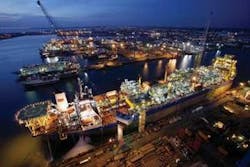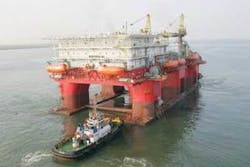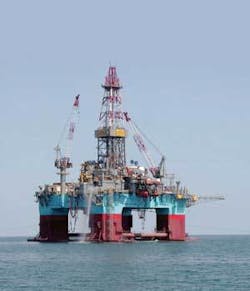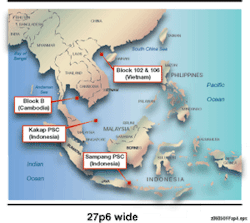Ramp-up in Asia-Pacific E&P fuels Keppel’s strategy
Gurdip Singh, Special Correspondent
Asian national oil companies have been aggressively building strategic international reserves to support demand in their respective countries. Among these growth-driven groups is Singapore’s Keppel Corp., but with a slightly different strategy -- to continue building on its technology-driven businesses and to service global hydrocarbon-producing industries.
Keppel’s international growth has resulted from the boom in global oil and gas development. It is led by Keppel Offshore & Marine, which has traditionally been active in the upstream sector, covering project activities in exploration, development, production, and abandonment.
“We have a strategy of ‘near market, near customer’, which is bolstered by a global network of 17 yards in the Asia-Pacific, Gulf of Mexico, Brazil, the Caspian Sea, Middle East, and the North Sea regions,” says Keppel O&M Offshore & Marine chairman and CEO Choo Chiau Beng.
“Keppel’s expertise is in all segments of providing high-end services to the high-risk and harsh environment operating businesses,” he says. “Technology is the keyword.”
The company’s expertise is in the design and construction of seismic vessels, a wide range of drilling units - including jackups, semisubmersibles, and drillships - support vessels such as tugs and supply boats, as well as maintenance vessels for construction, salvage, pipe-laying, and abandonment.
Keppel leverages its global yards
Choo says deepwater oil and gas production has been increasing rapidly, with expenditures expected to reach $20 billion per year by 2010. The expected growth in deepwater projects will also drive Keppel’s continued growth.
“Currently, deepwater oil production accounts for only 10% of total offshore oil production. But this is expected to increase to 25% by 2015,” Choo says.
Keppel positioned itself to meet the needs of such growth by developing in 2005 a joint venture company, FloaTEC, with J Ray McDermott. The JV provides deepwater production solutions in spars, extended tension-leg platforms, single column floaters, and semisubmersibles.
One of the concerns in the industry is the rising cost of projects. “When an industry is doing well, it is inevitable that costs will increase. We have a responsibility in managing such costs,” says Choo, adding that consultation with suppliers, customers, and contractors provides a means for cost management.
He highlights Keppel’s ability to solve cost issues with its network of 17 shipyards in strategic locations across the globe.
A recent example is theBlackford Dolphin contract across three yards - Keppel FELS and Keppel Shipyard in Singapore and Keppel Verolme in the Netherlands.
It is a fasttrack $177-million contract to upgrade semisubmersibleBlackford Dolphin, the former Ocean Liberator, built in 1974, to extend her life for 20 years.
When completed at the end of June 2007, the upgraded drilling unit will have drilling depth capabilities increased to 7,000 ft from 600 ft water depth, enabling her to operate in deepwater environments.
Work on the project started in March 2006. Keppel FELS will leverage resources from sister yards to carry out the job simultaneously.
Both Keppel Shipyard and Keppel Verolme are responsible for the fabrication of the lower and upper hull structures and modules. Keppel Verolme will undertake the overall integration of the structure and modules as well as carry out the repair and maintenance work on the semi.
In early April, the company won a contract worth $102 million from Diamond Offshore Drilling Inc. to upgrade the semi,Ocean Monarch. Work will start in mid-2006 with the rig expected to be operationally ready in 4Q 2008
Choo acknowledges competition from shipyards such as those in China and welcomes such industry-wide challenges. “As with any businesses, there will always be competition, but Keppel has the competitive edge, especially in proprietary technology.”
Keppel owns proprietary technology, such as the jacking and fixation systems for jackup rigs; R&D capabilities; project management capabilities; skills and engineering capabilities; as well as available infrastructure across its 17 shipyards.
Keppel’s proven track record for timely deliveries, says Choo, is another competitive advantage. “This reliability gives the customer confidence of completing projects on time.”
Keppel upgrades yards
With booming demand for upstream projects, Keppel Offshore & Marine is converting its shipbuilding and repair facilities in Singapore and the Philippines.
“We are using one of our yards in Benoi in Singapore, which we use to build supply boats, to build parts of jackups for the offshore business,” says Choo.
Keppel Batangas Shipyard in the Philippines is also being upgraded to take on the construction of fabricated steel components for offshore rigs. It is being equipped with facilities to undertake fabrication work outsourced by Keppel FELS from 2Q 2006.
“We are upgrading Batangas yard to carry-out offshore work as subcontractor for the Singapore-based Keppel FELS.”
The upgrading at Batangas yard includes a complete panel line system, a block assembly facility, and the installation of other heavy construction equipment.
“We aim to enhance our role in the offshore and shipbuilding industry. To do this, we have to introduce new systems, machinery, and equipment, such as CNC (computer numerically controlled) profile cutting machines, a panel line, and a covered block assembly facility with overhead gantry cranes,” says Keppel Philippines Marine Inc.’s President Toh Ko Lin.
He says it is critical to train and develop the Filipino workforce to undertake offshore rig construction work.
In doing so, a contingent of 23 engineers and skilled workers from Keppel Batangas Shipyard was posted to Keppel FELS Singapore in September 2005 for a two-month training program in rig construction and shipbuilding.
The training program includes various courses on shipyard safety, shop drawing interpretation, Tribon M3 applications for ship modeling, CNC profile cutting, advanced welding skills, dimensional control, marking, steel fabrication, quality control, and panel line shop on-the-job training.
Keppel Batangas had previously undertaken mainly traditional shipbuilding and ship repair and conversion projects.
Choo also highlights Keppel AmFELS in the GoM, saying it has the capacity for rig delivery through 2008-2009.
Keppel acquires E&P assets
Keppel Group is also involved in upstream E&P through its subsidiary Singapore Petroleum Co. Ltd. “SPC aspires to be an integrated oil and gas company, and building its E&P portfolio of assets is an integral part of its effort to achieve this vision,” says Choo. “SPC will continue to pursue its strategy of focusing on acquisition of upstream assets and strengthening its existing downstream business.”
Choo is also chairman of Singapore Refining Co., which operates a 285,000 b/d refinery and is involved in trading and marketing of oil and gas businesses.
Noting that E&P drive the earnings of the global integrated oil and gas companies, he says, “Moving into this arena gives SPC a counterbalance to its reliance on downstream activities.
“This will stabilize and grow earnings. Given the cyclical nature of the refining sector, it is good to build a stable contribution from E&P activities.”
SPC’s focus is on niche acquisitions mainly in the ASEAN region, where it has built up strong relationships with other regional national oil companies.
The current high price of oil has made the acquisition of further E&P assets extremely challenging, says Choo. “With a modest risk capital, SPC will continue to be cautious and selective in its approach toward acquisition of E&P assets.”
Choo expects SPC to retain its present participation as a co-venturer and continue to build its capability in this sector with the ultimate goal of operatorship in the future.
The company continues to evaluate E&P opportunities, whenever they become available. These include major producing assets mostly in Asia and farm-in opportunities in ASEAN countries.
In April 2004, SPC acquired a 10% participating interest in blocks 102 and 106, covering approximately 5,405 sq mi, in the Song Hong basin in the Gulf of Tonkin, Vietnam. In October 2004, an oil and gas discovery was made in the first exploitation well, Yentu-1X, in block 106.
SPC further expanded its upstream assets in 2004 through the purchase of El Paso Production Oil & Gas’ stake in Coastal Indonesia Sampang Ltd., which subsequently was renamed Singapore Petroleum Sampang Ltd. The stake includes a 40% interest in the Sampang production sharing contract, which contains the Oyung oil and gas field off the coast of East Java, Indonesia.
In January 2006, SPC began drilling the Jeruk-3 well to further appraise the Jeruk oil discovery located offshore East Java about 42 km east of Surabaya in water depth of 44 m.
Jeruk-3 is being drilled as a deviated well to penetrate the Kujung carbonate reservoir in a crestal area in the western part of the Jeruk structure. The well is anticipated to be drilled to approximately 5,500 m in measured depth (5,200 m vertical depth subsea). The drilling of the well was expected to take 90 days using Transocean’sSedco 601.
The partners are Singapore Petroleum Sampang Ltd. (SPC subsidiary)19.6%; Santos (Sampang) Pty Ltd. 40.5%; Medco Strait Services Pte Ltd. 22.5%; PT Petrogas Oyong Jatim 10.0%; and Cue Sampang Pty Ltd. 7.4%.
Last month, SPC started drilling the Dukuh-1 exploration well in the Sampang production sharing contract in Indonesian waters.
Dukuh-1, approximately 10 km south of the Jeruk oil discovery and about 40 km southeast of the city of Surabaya, was spudded on April 5.
SPC expected to take 44 days to drill the well to a depth of 3,200 m subsea to test tertiary sandstone reservoirs within a seismically-defined four-way dip closure.
SPC’s Singapore Petroleum Sampang Ltd. has 36% stake in the concession, with Australian Santos (Sampang) Pty Ltd. and Cue Sampang Pty Ltd., 40.5% and 13.5%, respectively.
PT Petrogas Oyong Jatim, a company wholly owned by the provincial government of East Java, is managing the 10% Indonesian participation interests within the East Java provincial boundaries such as the Sampang and Madura offshore PSCs.
SPC E&P activities expand
Indonesia: The company owns a 15% equity stake in the Kakap PSC, an oil and gas producing asset located offshore Indonesia in the West Natuna Sea. The Kakap PSC forms a consortium of three PSC blocks in West Natuna.
In 1999, SembCorp Gas entered into a 22-year contract with Pertamina to buy 2.5 tcf of natural gas from Indonesia. Gas supply to Singapore began in 2001 with Kakap PSC contributing 20% of the gas volume.
Net oil and gas production from the Kakap PSC averaged 2,600 boe/d in 2004. Plans are in place to explore for additional oil and gas resources in the Kakap PSC in 2006.
SPC owns a 40% working interest in the Sampang PSC, located offshore East Java, Indonesia. The Sampang PSC contains the Oyong oil and gas field, the Jeruk oil discovery, and several exploration prospects and leads.
The Oyong oil and gas field is currently under development. The field development comprises two phases, with phase 1 for oil and phase 2 for gas. Phase 1 is currently under development with first oil production expected to be in 1Q 2006. Phase 2 will begin soon with first gas expected toward the end of 2006 or early 2007.
In late 2003, the Jeruk discovery was made with the drilling of an exploration well, Jeruk-1, located offshore East Java about 42 km east of Surabaya in water depth of 44 m.
In October 2004, Jeruk-2 ST2 (side track) tested 7,500 b/d of oil.
In April 2005, SPC exercised its rights to reinstate its 40% participating interest in the Jeruk discovery and to participate in the current appraisal program. The appraisal program began in May 2005 with the drilling of Jeruk-2 ST4/ST5. In September 2005, Jeruk-2 ST5 had tested 3,000 b/d and Jeruk-2 ST4/ST5 was suspended following the completion of production tests.
In January 2006, drilling of the Jeruk-3 well began to further appraise the Jeruk oil discovery. Jeruk-3 is being drilled as a deviated well to penetrate the Kujung carbonate reservoir in a crestal area in the western part of the Jeruk structure. The well is anticipated to be drilled to approximately 5,500 m in measured depth (5,200 m vertical depth subsea). The drilling of the well was expected to take 90 days.
The partners are Singapore Petroleum Sampang Ltd. (SPC subsidiary)19.6%; Santos (Sampang) Pty Ltd. 40.5%; Medco Strait Services Pte Ltd. 22.5%; PT Petrogas Oyong Jatim 10.0%; and Cue Sampang Pty Ltd. 7.4%.
Last month, SPC started drilling the Dukuh-1 exploration well in the Sampang production sharing contract in Indonesian waters.
Dukuh-1, approximately 10 km south of the Jeruk oil discovery and about 40 km southeast of the city of Surabaya, was spudded on April 5.
SPC expected to take 44 days to drill the well to a depth of 3,200 m subsea to test Tertiary sandstone reservoirs within a seismically defined four-way dip closure.
Vietnam: SPC holds a 20% participating interest in blocks 102 and 106, located in the Song Hong basin, offshore in the Gulf of Tonkin, Vietnam. Blocks 102 and 106 cover an area of 14,000 sq km and contain several exploration prospects and leads.
In October 2004, oil and gas were discovered upon the drilling of Yentu-1X, the first exploration well in block 106.
A 600 sq km 3D seismic survey over two areas in these blocks was completed in June 2005 to further evaluate the Yentu-1X discovery and the other prospects in the blocks. SPC plans to drill a second well in block 106 in the first half of 2006.
Cambodia: In August 2005, SPC entered into an agreement with the Royal Government of Cambodia for a 30% interest in the block B petroleum agreement. Block B is located 250 km off the coast of Cambodia to the east of the Thai-Cambodian Overlapping Claims Area in the Gulf of Thailand. The block lies to the southeast of the Khmer basin where a number of oil and gas discoveries have been made.
SPC plans a three-year exploration program, which includes the drilling of one exploration well and the acquisition of 200 sq km of 3D seismic data.




